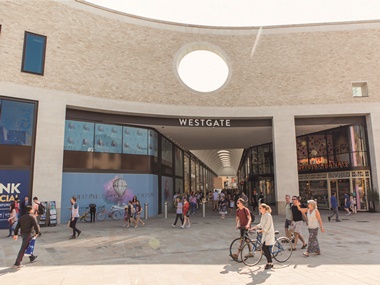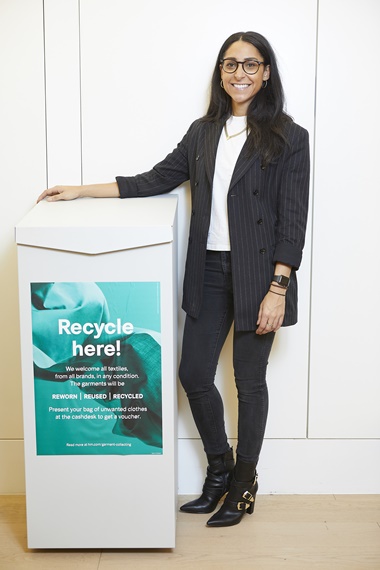Decluttering your wardrobe has become a somewhat unlikely fashion trend lately. Consumers have been encouraged to delve into their drawers and emerge with bags bulging with unwanted clothes thanks to Netflix’s Tidying Up with Marie Kondo, in which the lifestyle guru encourages people to get rid of junk – starting with their wardrobes.
But despite Kondo’s best efforts, there is work to be done. The amount of clothing sitting in wardrobes – or, worse, going into landfill – each year remains a major challenge for the fashion industry. The British public is sitting on £4.1bn in used clothing – the equivalent of £82 per person – research published last month by the Fashion Retail Academy shows. And data from sustainability organisation the Ellen MacArthur Foundation suggests that, worldwide, one rubbish truck of textiles is burned or goes into landfill every second.
If retailers and brands hope to address the problem, the opportunity to be a “force for good” comes with demands – from managing the logistics of a take-back scheme to ensuring customers are aware and fully engaged. But fashion retailers are being prodded into action thanks to a combination of increased awareness around sustainability, the risk of significant reputational damage and the threat of government intervention.
![]()
How sustainable is your business?
Drapers’ new survey is aimed at providing a comprehensive measurement of how sustainable UK fashion is, and how far it has to go.
We want to find out what challenges retailers face when it comes to embedding sustainability into day-to-day working practices, and obtain views on government support for the industry.
The survey only takes a few minutes to complete and all answers will be treated anonymously.
Govermental demands
Pressure on brands can come from below – customer outcry – or above, in the form of pressure from government. Last summer, luxury brand Burberry pledged to stop burning unsold goods after it was criticised summer for setting light to millions of pounds worth of clothes, accessories and perfume to try to maintain exclusivity. In February, MPs urged the government to introduce a 1p levy on every item of clothing sold to fund better recycling and “end the era of throwaway fashion.”
The environmental audit committee made the suggestion in its final report on the sustainability of the fashion industry. It said a 1p garment tax as part of a new “extended producer responsibility” scheme could raise £35m for investment in better clothing collection and recycling in the UK.
The report highlighted the French model as an example. In 2007, France introduced an extended producer responsibility scheme that makes clothing, linen and footwear companies responsible for products at the end of their life. The number of clothing collection points rose from 15,600 in 2011 to almost 42,000 in 2016. In 2009, France was collecting 1.9 kg of discarded clothing, linen and footwear per person per year. By 2016, it was 3.2kg. More than 90% of what is now collected is recycled or re-used.
The retail industry has a huge opportunity to be a force for good
Tom Byrne Landsec
Some fashion retailers are introducing recycling or take-back schemes to try to ease their waste troubles. Value retailer Primark will introduce an in-store take-back scheme later this year, and already works with charity Newlife, which collects, sorts and recycles unsold Primark goods and buying samples to raise money for children with disabilities.
“Launching an in-store customer recycling scheme is a natural next step for us,” a Primark spokesperson tells Drapers. “Following a pilot in five stores in the UK and Germany (at Reading, Lakeside, Frankfurt Zeil, Frankfurt North-West Zentrum and Weiterstadt), we will be rolling out the scheme in our stores this year. Customers will be able to donate their unwanted garments, textiles and shoes, from any brand, in store to be repurposed or recycled.”
Property company Landsec introduced a landlord-led recycling pilot initiative in March at its Westgate Oxford shopping centre.

Landsec’s Westgate Oxford hosted a landlord-led recycling scheme
“We wanted to engage with consumers on why textile waste is a problem and the steps that can be taken to reduce fashion’s impact on the environment,” Landsec’s sustainability manager Tom Byrne tells Drapers. “The retail industry has a huge opportunity to be a force for good, and now is the perfect time. There’s been a huge wave of support for reducing waste, which started with an awareness around single-use plastics and coffee cups, and is moving into textiles.”
Swedish retailer H&M has been collecting unwanted clothes from any brand since 2013. All H&M stores contain a garment collecting box and the business collected 20,000 tonnes of textiles in 2018. Its next ambition is to collect 25,000 tonnes by 2020. Clothing that can be worn again is sold second-hand (proceeds go to the British Red Cross and the H&M Foundation), older clothes are repurposed into other products, and the remainder is broken down into textile fibres. Customers receive a £5 voucher to use on their next purchase of £25 or more when they drop off unwanted clothes.
To introduce a successful recycling scheme, retailers need to focus on simplicity and communication, says H&M’s UK and IE sustainability manager Giorgina Waltier.
“Old clothes and textiles may no longer be wanted by their owners, but they are definitely not waste,” she explains. “It is our responsibility to help our consumers to understand this and to dispose of their unwanted clothes in the most sustainable way possible. Recycling schemes need to be easy and straightforward for the customer to use. Likewise, communication around the scheme also needs to be easy to understand and transparent.”

“Old clothes and textiles may no longer be wanted by their owners, but they are definitely not waste” – Giorgina Waltier, H&M
Overcoming hurdles
However, introducing a take-back or recycling scheme is not without its challenges. Retailers need to identify the right partner, communicate with customers and ensure they have enough human resource to gather, sort and transport what they collect.
“The main challenges regarding the introduction of a new recycling scheme are logistics and traceability,” adds Waltier. “Knowing exactly how the customers’ unwanted textiles are being processed once they leave your business and arrive in the hands of your recycling partner is your responsibility. Ensuring that these textiles are handled in the right way is non-negotiable.”
Consumers might be happy to pay lip service to sustainability, but ensuring they engage with recycling schemes is another hurdle, says Jack Ostrowski, founder of fashion recycling app Regain. Regain users pack unwanted clothes and then drop them off at a local pick-up point, unlocking discount codes to use at participating retailers. Regain’s partners include Boohoo, Missguided, New Balance and Superdry.
“There is still a big education piece that needs to be done when it comes to consumers and recycling,” Ostrowski explains. “It is getting better, but a lot of people are still throwing their clothes into landfill, even in cities with a sophisticated understanding of the issues, such as London. We’re only on the beginning of a long road when it comes to changing consumer behaviour.”
We need to start a conversation with consumers to show them how to start to make better decisions
Romy Miltenburg, Asics
Ostrowski urges retailers to start talking to consumers about what to do with end-of-life product as early as possible to help ease this challenge.
“Why are we not telling customers what to do with their product when they’ve finished with it at the point of purchase? It would be easy to include on boxes or packaging, or at the checkout. There are so many ways to communicate sustainability very practically that could change things from day one.”
Romy Miltenburg, manager for CSR and sustainability EMEA at Asics, agrees that communication and logistics are at the heart of a successful take-back scheme. The sportswear brand has partnered with recycling services provider I:Co to collect used sports clothing from participants of eight marathons around Europe this year.
“We need to start a conversation with consumers to show them how to start to make better decisions,” says Miltenburg. “Finding the right recycling partner – one who shares your vision – is important. Internally, there is the operational side to consider. There are practicalities to think about with your logistics and facility teams, because what you collect needs to be emptied, sorted and transported.”
Miltenburg adds that success hinges on both internal and external stakeholders engaging with the scheme: “It is important internally that employees understand where [recycling schemes] fit it into the overarching sustainability strategy, so that there is a sense of shared responsibility to make it a success. And communication is key, because we need participants to be prepared and bring something with them that they want to donate.”
But despite the difficulties, sustainable initiatives such as recycling schemes, can have tangible benefits for retailers. Finn Christo is group head of ecommerce at vegan footwear brand Koi, which has partnered with Regain.
He explains that the brand’s sustainable focus is paying dividends: “Generation Z and millennials have the information that they need to make conscious decisions, and they know they don’t have to choose between having values and ethics and stylish products. By listening to our customers, and recognising that choices such as being cruelty free, vegan and working towards sustainability are a key issue for them, we can build brand loyalty.”
Recycling initiatives are one way fashion retailers can begin to tackle the industry’s waste problem. Those looking to introduce such schemes need to engage stakeholders from across the business, consider operational challenges and communicate clearly with consumers for success.
